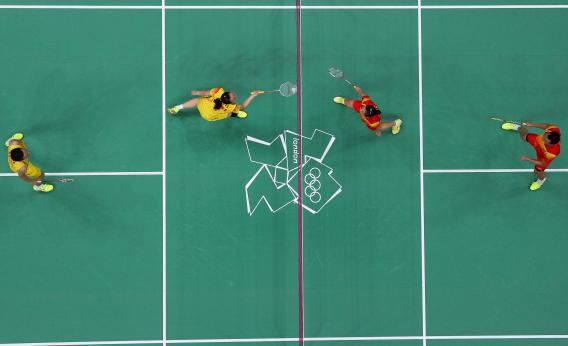On Tuesday, eight badminton players from three countries were chucked out of the Olympics for trying to lose. As Justin Peters reported in Slate, this wasn’t a sudden fit of self-sabotage; there was a method to it. A Danish team had upset the Chinese pair of Tian Qing and Zhao Yunlei in the opening round-robin segment of the women’s doubles event. This threw the bracket for the single-elimination segment into disarray and cast a subsequent match—between a second Chinese team (Wang Xiaoli and Yu Yangin) and a twosome of South Koreans—in a rather strange light. The winner would likely have to face Tian and Zhao, ranked No. 2 in the world, while the loser would have an easier draw to reach the finals. (And I haven’t even gotten into the Indonesian part of the story—but go to Peters for the gory details.) Under the circumstances, losing was a winning strategy.
Could the tournament have been designed differently to avoid these crazy incentives? Yes, and here’s one way you could do it.
There are 16 women’s doubles badminton teams in the Olympic tournament. In the current system, these teams are split into four groups of four—groups A, B, C, and D—for preliminary-round play, then placed into an eight-team, single-elimination bracket based on how they do in the prelims. The design of that eight-team bracket is predetermined: The winner of Group A (A1) plays the second-place team from Group C (C2), while B1 plays D2, C1 plays A2, and B2 plays D1.
The fact that the elimination-round bracket is determined in advance is what made losing so attractive for some teams. You’re supposed to play your best in Group B so that you can be the top finisher, B1; then your first elimination game is against D2 instead of the top finisher D1. But if D2 is actually Tian and Zhao, you might be better off being B2 instead of B1. But so might your opponent. And that’s when players start whacking shuttlecocks into the net on purpose.
How would our modified badminton tournament fix this problem? The preliminary rounds would be exactly the same. As in the current system, the first segment would split the 16 entrants into four four-team groups A, B, C, and D. Each group would play a round-robin, and the top two finishers in each group would advance to the eight-team knockout round.
At that point, we would put the bracketing in the hands of the competitors themselves. At the end of the round-robin, we conduct a random draw of the top finishers—A1, B1, C1, and D1. Based on the order of the draw, each team in turn is allowed to pick their first-round opponent. There are a few unlikely edge cases to be careful about. For example, you want to allow A1 to pick B1, C1, or D1 if they want; after all, this year’s D1, the Danish team, would be an easier opponent than Tian and Zhao at D2. But what if A1 chooses to play B1 and C1 chooses to play D1? You still need to schedule two more first-round games, so you randomly pick one of the second-place round-robin finishers and let that team pick its opponent. (You might also want to include an additional rule that disallows two teams from the same round-robin group from meeting again in the first elimination round.)
Now your quarterfinal round is set. What about the semifinals? The winner of A1’s game plays the winner of B1’s game, and the winner of C1’s game plays the winner of D1’s game. If the organizers want to increase the odds that the top two teams in the world will play in the gold-medal match, they can put one in group A and one in group C. The two favorites can guarantee they won’t face each other until the final by doing what they’re supposed to and winning their respective round-robin groups.
If the 2012 competition operated under these rules, no team would have derived any benefit from tanking in the prelims. If Wang and Yu had won the match they ended up losing on purpose, they wouldn’t have been forced into the same semifinal as their Chinese teammates. Instead, Tian and Zhao’s place in the bracket would be determined essentially at random, since no team would choose to face the Chinese powerhouse in the first round unless they were the last ones to pick. And by winning, Wang and Yu would give themselves some power to choose their first-round opponent, an advantage the loser of their match would not enjoy.
Any rigid system is vulnerable to unexpected turns of events, and I’m sure this one is, too. Some concerns are raised in the comments in this excellent blog discussion, where a similar system is proposed. For instance, a top team already assured of advancing could intentionally lose to a patsy, helping the patsy make it to the elimination round over a more talented rival. But this strategy is possible in the current system, too. And in that scenario at least only one team would be trying to lose. That’s shady but forgivable, while the spectacle of both teams dogging it makes a mockery of the whole enterprise.
The “choose your bracket” model does seem to have the property that it’s always better to come in first in your group than second. That feature, in my view, is indispensable. As we saw this week, the current Olympic system doesn’t offer it.
